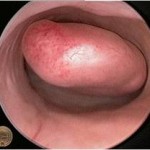
No, it's not what you think. This isn't a holiday greeting. The Three H's I'm referring to are:
HysterOsonogram, HysterOsalpingogram, and HysterOscopy
Your doctor may recommend that you have one or more of these procedures done. They are not nearly as intimidating as their names might suggest. Let's take a look at them one by one:
A Hysterosonogram (also known as HSN or sonohysterogram) is a special ultrasound of the uterus. Normally, the walls of the uterus are touching each other so that when viewed in a regular ultrasound the inside of the uterus cannot be seen. In an HSN, the doctor inserts a very thin, flexible tube through the vagina and fills the uterus with saline. This makes it expand like a balloon, and then we can see any abnormalities inside the uterus. For example, if there is a polyp present (a small piece of tissue attached to the wall of the uterus), it could interfere with implantation of an embryo. There are no special instructions required before you come in for an HSN. The entire test only takes about 5 minutes, and it usually causes little or no cramping.

A Hysterosalpingogram (also known as HSG) is an X-ray of the uterus and fallopian tubes. In this test, your doctor injects a special dye through the vagina again using a very small tube. This dye fills the uterus and the fallopian tubes and allows us to see if there are any abnormalities. This test is especially helpful in determining if your tubes are open, because we can see if the dye spills out of the end of each tube. Sometimes if one or both tubes are closed, your doctor can try to open them during the HSG. When you schedule your appointment for an HSG, you will be instructed to take either 800 mg of ibuprofen (Advil or Motrin) or 2 Extra Strength Tylenol about one hour before your procedure. This helps to prevent any cramping you might experience. An HSG only takes about 10 minutes to perform.

A Hysteroscopy (also known as HSC) is a procedure that is used when your doctor sees something in the uterus during an HSN or HSG that doesn't belong there and needs to be removed. During an HSC, you will be put to sleep with IV sedation and then your doctor will insert a thin fiber optic telescope with an attached tiny video camera through the vagina and actually see inside the uterus. Using tiny scissors, your doctor can then easily remove any tissue such as a polyp without any incision or stitches. Because you are given anesthesia to put you to sleep during an HSC, you will be instructed to have nothing to eat or drink after midnight before the morning of your procedure. You will also need to have someone with you to drive you home and stay with you for the remainder of the day. An HSC usually only takes about 15-20 minutes to perform, but you will need to arrive approximately 30 minutes before the procedure and stay in our recovery room for about 1 hour after the HSC is done. Generally, you would experience only mild cramping afterwards and can return to your normal activities the next day.

All of these procedures are usually performed between days 5 and 12 of your menstrual cycle. This is to insure that you are finished with any heavy bleeding, and that you have not yet ovulated and therefore are not pregnant at the time of the test.
So, I hope this information helped show you that the Three H's are not nearly as bad as they might sound, and more importantly they give your doctor immediate information that can help you in your journey to achieve pregnancy.
Happy Holidays!
HO, HO, HO

Entire Website © 2003 - 2020
Karande and Associates d/b/a InVia
Fertility Specialists
